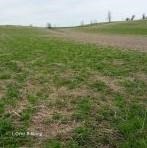Some alfalfa fields are having a rough time. Unavoidable winter injury can occur on any dormant plant in the field. If heaving did not occur, the winter ice, freezing temperatures, or lack of snow cover this past winter could still have impacted the plant’s ability to survive and regrow this spring. Current cool weather and recent frost is not helping plant growth or recovery either.
Consequently, it may not be surprising to find alfalfa plants with rotted crowns or roots. If new growth from the alfalfa crown appears delayed, yellow, or down right ‘crappy-looking’, it is a good idea to double check the health of the crown and roots.
Look for symptoms.
Rotting is prevalent. Development of crown rot is favored by plant stress, age of the plant, damage to the crown, or insect damage. It is a caused by a complex of soil micro-organisms that target plants that are stressed, damaged by insects, or exposed to unfavorable environmental conditions. These organisms can infect and rot the crown and roots of alfalfa throughout the year, however, this year winter injury appears to be a factor.
Crown rot is generally described as brown, dead areas in the crown of the plant that can extend down through the cortex of the root (see Photo 1 below). At later stages of the disease, the center core may become completely rotted and hollow. As crown rot develops, plant vigor declines, and alfalfa plants appear stunted; they begin to wilt and eventually die.
Assess your stand.
What should you do? Start by estimating your yield potential. Counting stems is a proven method for determining yield potential of your current alfalfa stand. Dr. Dan Undersander and others with UW-Extension found a correlation between tons dry matter yield per acre and the number of stems per square foot. Typically greater than 55 stems per square foot will not limit yield, but if the field averages less than 39 stems per square foot, one should consider replacing the stand. It is always best to average stand counts from three to five representative locations per field.

Do not rely on stems alone. After counting stems, assess the overall crown and root health at each location in the field. At each location where you counted stems, dig 5 plants, deep enough to capture about 6 inches of the crown. To assess crown rot, follow the protocol outlined in the UW-Extension Team Forage publication (A3620) at http://fyi.uwex.edu/forage/alfalfa-stand-assessment-is-this-stand-good-enough-to-keep/. This publication provides guidelines for assessing whole plant health and images useful for rating alfalfa crown and root health on plants slit in half to check for discoloration.
Determine management strategies.
Different management strategies may be required depending on the extent of winter injury to your alfalfa stand. Is it time to renovate your existing alfalfa stand, recover what you can, or rotate to another crop? Strategies might include allowing plants to mature longer before cutting; increasing the cutting height; applying adequate fertilizer; controlling weeds; allowing adequate food reserves to build up in the fall. A helpful tool for calculating your risk for winter injury and determining what management practices to select can be found in the UW-Extension Focus on Forage article online at: http://fyi.uwex.edu/forage/evaluating-and-managing-alfalfa-stands-for-winter-injury/
First decide the extent of winter damage in and yield potential of your field, then based on your farm and forage needs decide when and what options you need to take.